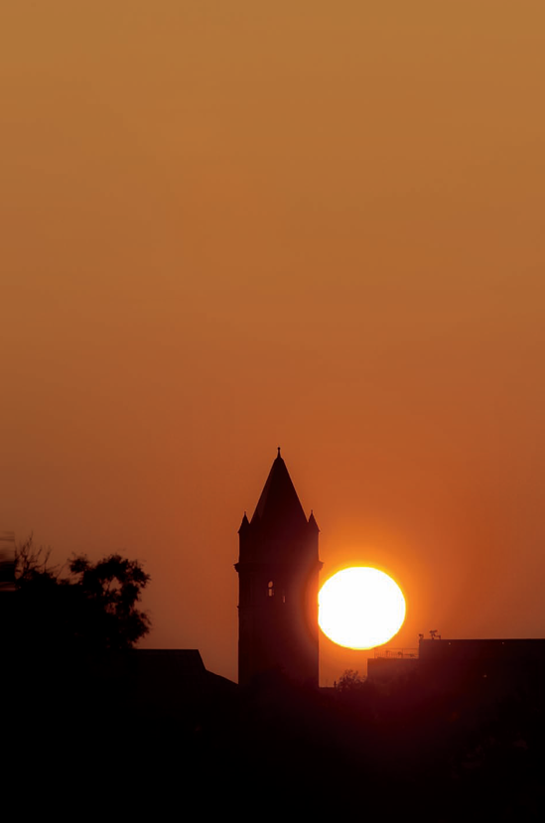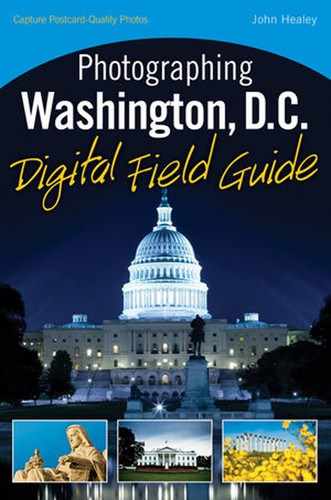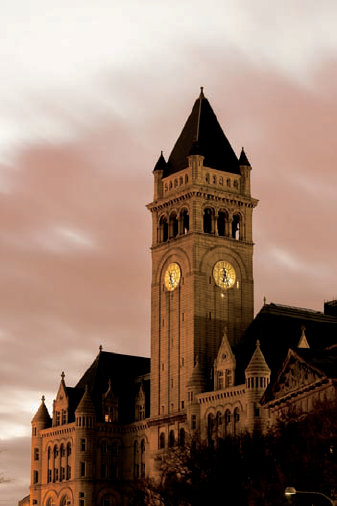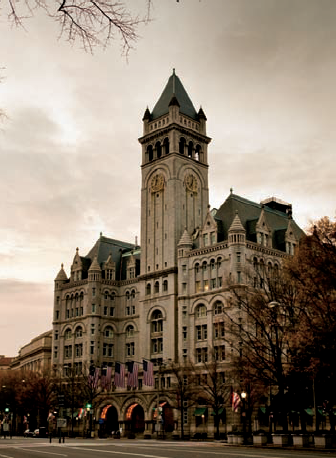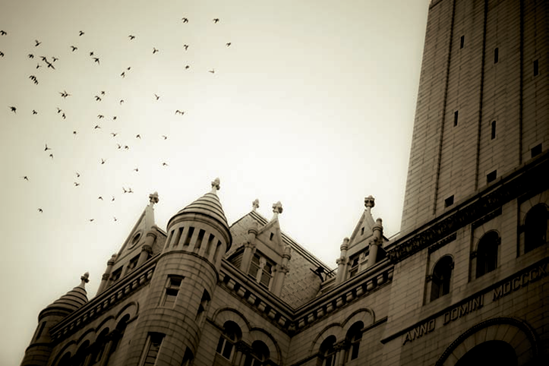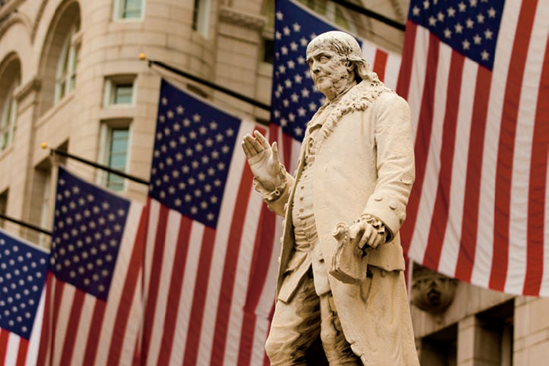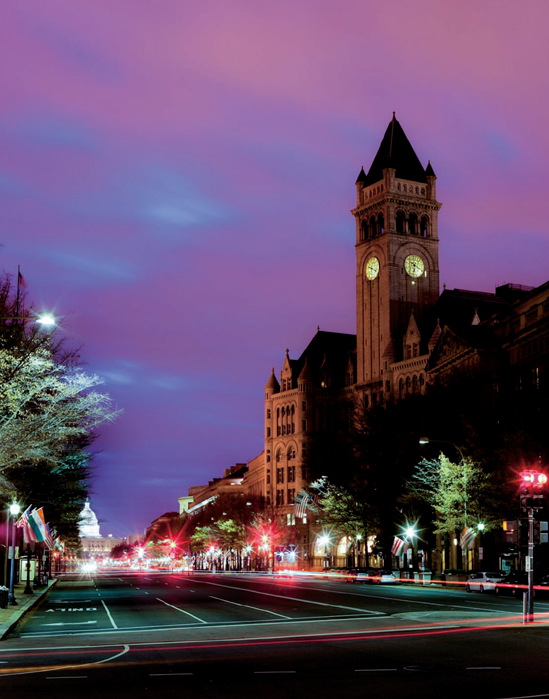
The Old Post Office during early evening. Taken at ISO 200, f/11, 25 seconds with a 50mm lens and a tripod.
The Washington, D.C. skyline is punctuated by a few landmarks that everyone knows, such as the Washington Monument, the U.S. Capitol, and the Smithsonian Castle. And then there's the one that most people don't recognize. It looks somewhat like a cathedral from Medieval Europe, albeit with a clock tower.
It was originally conceived to house both the U.S. Post Office Department headquarters and the post office for the District of Columbia. Today, the Old Post Office is undeniably an interesting contrast to the strict classicism of Federal Triangle buildings built in the 1930s and the blocky, monolithic designs of buildings constructed in the 1970s.
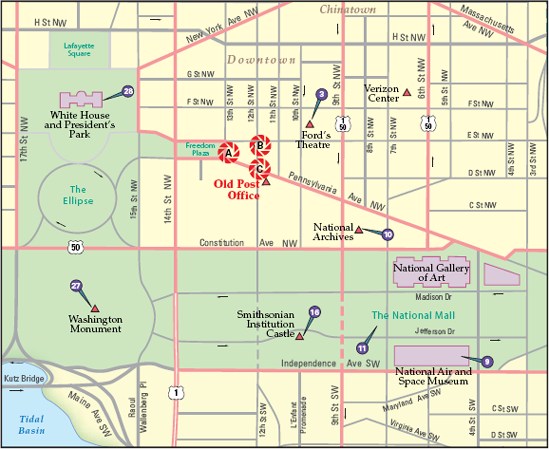
Figure 14.1. The best locations from which to photograph the Old Post Office: (A) the 1300 block of Pennsylvania Avenue NW, (B) the 1200 block of Pennsylvania Avenue NW, and (C) in front of the Old Post Office. Nearby photo ops: (3) Ford's Theatre, (9) National Air and Space Museum, (10) National Archives, (11) National Mall, (16) Smithsonian Institution Castle, (27) Washington Monument, (28) White House and President's Park.
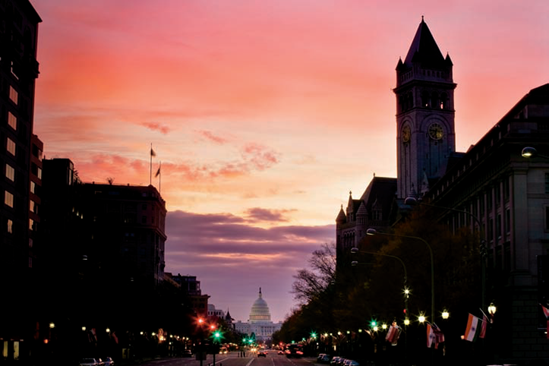
Figure 14.2. The Old Post Office and the Capitol in the morning (see A on the map). Taken at ISO 100, f/29, 3 seconds with a 70mm lens mounted on a tripod.
Here, beside what is known as Freedom Plaza on the north side of the block, you can get a nice image of Pennsylvania Avenue as it leads up to the U.S. Capitol. This is a great vantage point from which to photograph the Old Post Office.
Depending on where you stand along this block of Pennsylvania Avenue between 13th and 14th St. NW, you can either photograph the building alone or with the Capitol in the distance (see figures 14.1 and 14.2).
This is an alternate location where you can get a more frontal view of the Old Post Office, as well as many of its architectural details from the north side of this block (see Figure 14.3).
Here, you can get some closer images of the building (see Figure 14.4), as well as a somewhat haggard-looking statue of Benjamin Franklin (see Figure 14.5). The statue was originally a gift of Stilson Hutches, the founder of the Washington Post, and was dedicated on Franklin's birthday on January 17, 1889 by Franklin's granddaughter, Mrs. H.W. Emory. It was moved from its original location at 10th St. and Pennsylvania Avenue NW to this site in 1982.
Getting a nice photo here is fairly easy because of the open space and nice vantage points, especially as you look down from the 1300 block of Pennsylvania Avenue.
Here focal lengths from 35mm to 100mm are the rule, except if you want to photograph the building from a closer vantage point near 12th St. NW.
One of the best tips for photographing buildings is to use the longest focal length possible, because it prevents distortion to the building. The photos from the 1300 block of Pennsylvania Avenue (refer to Figure 14.1) are therefore a bit easier on the eyes with regard to architecture because a 70mm lens distorts less than a wider-angle lens. With the Old Post Office, you'll have the option of using the lens you prefer or the one you have: The longer the focal length you choose, the farther west you can head on Pennsylvania Avenue NW.
If you do use a wide-angle lens with architecture, you can reduce the amount of distortion to a degree by using a lens distortion correction filter in an image-editing program. Such filters are also useful to learn about how lenses affect architectural details in general.
Photo enthusiasts who wish to use a tripod can do so briefly as long as they don't cause any obstruction (see this book's Introduction for more information about tripod use). If you choose to use one without a permit, note that the proximity of these photography locations to the White House, Capitol, and other high-security buildings adds to the likelihood of additional scrutiny. A small, table-top tripod can be used from the Freedom Plaza area along the north side of the 1300 block of Pennsylvania Avenue. You can place the mini tripod on one of the many walls or planters.
The camera settings you use largely depend on when you choose to photograph the Old Post Office. At the most basic level of photography, you want to be sure to correctly meter on the building during the daylight hours so that your image isn't too dark or light. If your camera has Center-weighted or Spot metering modes, use it to set an exposure off the building. Because the Old Post Office is a neutral gray color, your camera's meter should set an accurate exposure when based on it. If you need to recompose, note the settings you had when metering on the building and then manually set those after recomposing.
Another method of determining the correct exposure is of course to look at the image displayed on your camera as well as to use your camera's histogram (the graph that can be seen with the image on many cameras). The histogram is simply showing you how much of the darks, midtones, and bright tones are in an image: The darks and blacks are on the left, midtones are in the middle, and bright whites on the right.
A well-exposed image generally has the bulk of its tones within the middle of the graph. An overexposed image will weight the graph to the right, whereas an underexposed image will weight it to the left. This guideline is by no means a hard-and-fast rule, because images with lots of white in them would have a histogram that shows much of the information in the bright and white areas (right side) of the graph, whereas a night image may have little information in the bright areas and a lot in the dark areas of the graph (the left).
Because there may be a bright sky surrounding the buildings, your camera may set an exposure that will render the scene too darkly. If this happens, it is because your camera is metering the bright sky, not the darker building. By adding exposure with the exposure compensation function, you can brighten up the picture and get a better overall image. Or you can try to meter more specifically on the building, or a combination of both.
If you are photographing the Old Post Office toward the early morning or night, try setting a slower shutter speed such as 1/15 or 1/30 second and holding your camera very steady: This will let the cars and people blur a little, and reduces their distraction in the image as well as adding a different look than what people are used to seeing. (Your camera's Shutter Priority setting would be good for this.) If you hold still, you can get a similar image to what you would get when using a tripod.
Think about the kind of photograph you want when shooting here to determine the correct time of day you want to photograph the Old Post Office.
The front of the Old Post Office faces north, which means that it doesn't often receive direct sunlight. Although some may see this as a limitation, it can be used to good effect because there will be more variance in the way the building is lit when the sun is rising and setting. Also, it can help to even out the exposure between the building and the sky. Because the building is never directly lit from the front or back, you have a better chance of getting a more even exposure at different times of the day.
As for the ideal time to shoot, because you will be facing east for some of these photos, working during the morning when the sun has risen and is directly opposite of you will be problematic (but of course that doesn't mean that a potentially interesting photograph can't be made then). Working with the sun behind you is the usual photographic advice, and it is indeed easier to work with — and for shooting the Old Post Office, it's a good idea.
If you're going for interesting color shots, you want to go in the morning and evenings, when the color in the sky is at its peak. Black-and-white photographs have a lot more options for light, including midday.
Because there can be plenty of sky in these images, an interesting sky will help add a creative element to your photographs. Before and after storms, weather fronts and interesting clouds can all be used to good effect. If the weather is less than spectacular, try to envision the images as black and white or with muted color. You can always find a creative answer to most any weather challenge.
If, however, the weather is less than ideal and you want to wait it out, the inside of the Old Post Office can be a good retreat: A trip up its clock tower can be done in any weather and offers scenic views of the city.
One note here is that because you are photographing in the downtown area, any low-hanging clouds will reflect the city lights, and the sky will take on a yellow-orange color when the sun has gone down. When mixed with the natural evening or morning light, this scene can take on an interesting look (see Figure 14.6).
The Old Post Office's many details can be explored for no less than a full city block, so there are plenty of options here. Try using subtle angles with your camera to create a dynamic look with your pictures.
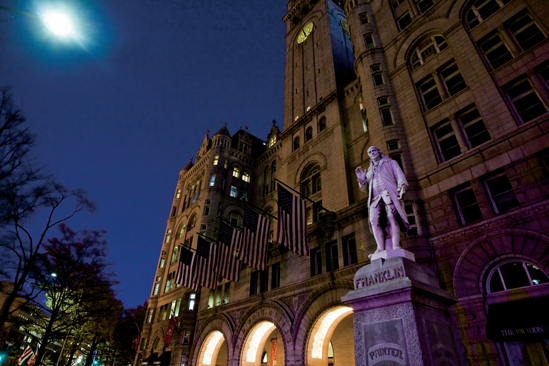
Figure 14.7. The front façade of the Old Post Office at night (see C on the map). Taken at ISO 3200, f/2.8, 1/15 second with a 20mm lens.
